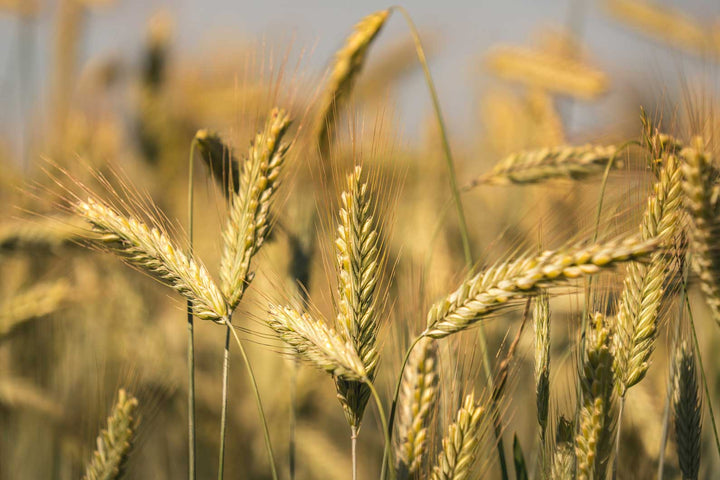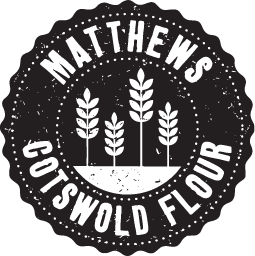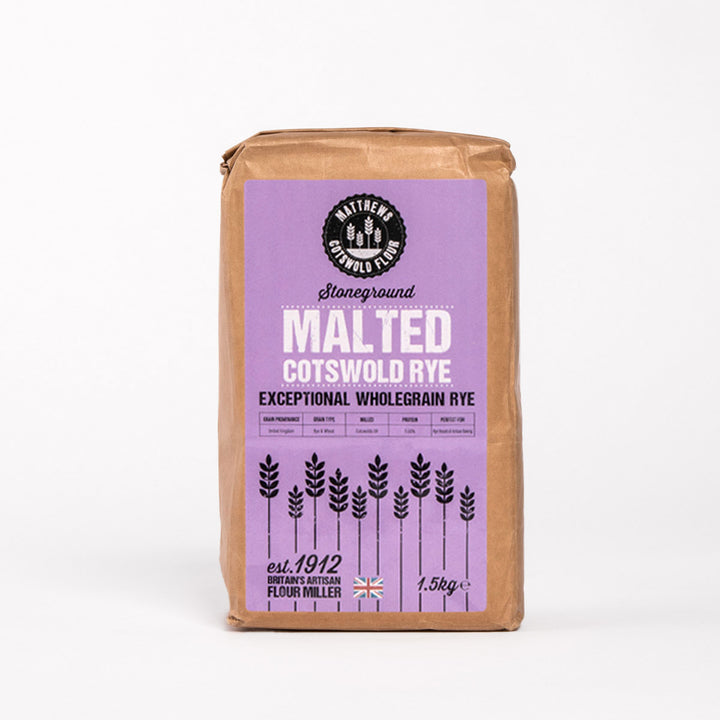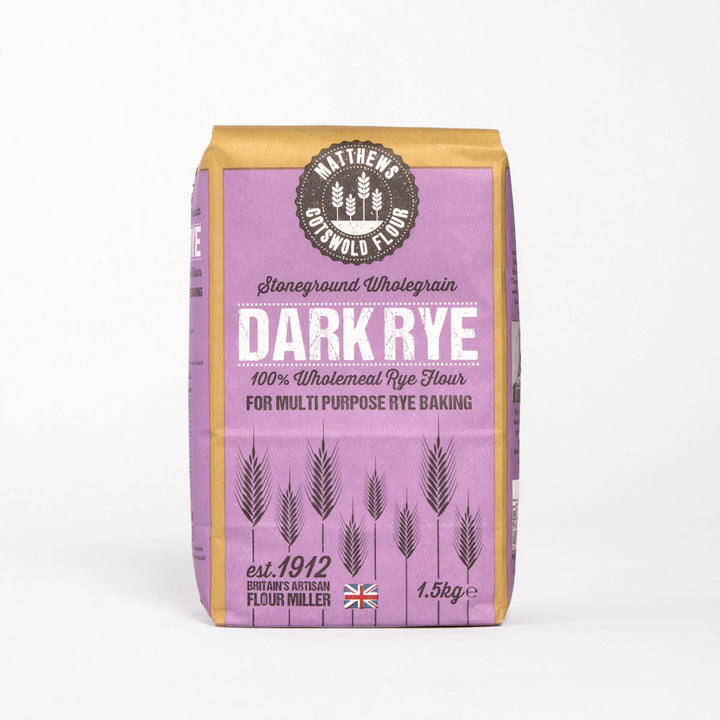Cotswold Rye Flour - Flavourful and Nutrient Rich

Rye is one of our favourite grains to grow, mill and bake with. Our family has sourced rye from growers around the Cotswold and UK for generations. It has a distinctive deep flavour to it, grows well on the Cotswold hills and requires very little inputs for farmers. Wholegrain Rye is nutrient rich, full of fibre and has a high level of activity in sourdough bread.

Rye Grain: (Secale cereale) is a grass part of the “Poaceae” family. Rye is extensively grown as a grain used to make delicious Rye bread and Rye whiskey. Rye is often described as an ancient grain which I would say it is not.
There are three types of varieties:
- Older conventional varieties that have a characteristic tall stem which can be prone to lodging.
- More modern “Hybrid” varieties that are higher yielding and more suited to farmers.
- There are Organic varieties which are slightly lower yielding.
Rye Grain History
The original Rye grains started in southwest Asia over 6000 years ago, they then migrated through the Balkans to Europe around 500 AD. Due to its tolerance of variable conditions it overtook wheat, barley and Oats in northern Europe. Rye is a great grain to grow in unfavourable conditions a bit like our own Cotswold brash near the Cotswold Mill. It is also a good winter as Rye does not mind the cool winters as much. Rye is popular in Germany, Baltics, Scandinavia, Poland, Ukraine, Russia and Denmark. Today world Rye production is only 3% of wheat.

Rye for Farmers and growers
Rye is a fast growing, winter hardy annual with long linear leaves. Rye is adapted to a wide range of soils but requires moderate fertility and moisture. It has a tall stem at 1 to 2 metres. Rye yields 2.5 to 4T per acre depending on variety and growing practices. There are three types of varieties.
- Older conventional varieties that have a characteristic tall stem which can be prone to lodging.
- More modern “Hybrid” varieties that are higher yielding and more suited to farmers use 25% less water/ha.
- There are Organic varieties which are slightly lower yielding.
Reasons to grow
For farmers Rye can be a great choice due to its low nitrogen input, low disease risk, high straw yields and high demand millers, distillers, and pig finishing units.
Risks
Rye is a fast-growing grain that can be prone to lodging as it can grow to over 2 metres. Rye can suffer from a particular strain of brown rust (puccinia recondita) that can be exacerbated in high temperatures (20 - 26°C and warm nights (15°C) causing yield losses. Rye can also be prone to ergot; this risk can be mitigated by processing the rye grain through our modern colour sorter at the Cotswold Mill. The colour sorter has the ability to ensure accurate admixture removal, species separation, ergot removal.
Rye characteristics
Rye seed is similar to wheat but is smaller and darker. The leaf colour is a blue green. Best time to seed Rye grain is between 15th August to 30th of September.

Rye flour for Bakers: Generally, Rye requires less handling than wheat flour. Rye has lower gluten levels so blending with a wheat flour can help balance this.
- Rye enhances the sourdough fermentation: Rye attracts more yeast than other flours; it becomes more active when used in rye sourdough baking.
- Long fermentation boosts flavour: Rye breads have that unique complex rich flavour. The high nutrient profile and enzyme activity add to this flavour. If you are looking to enhance these flavours then use a long fermentation process or put the dough in the fridge for an overnight to prove overnight.
- Blend for light higher loaves: Wholegrain rye will be generally denser in character which is not for everyone. If you are looking to enhance your bread with that unique rich rye flavour but want a higher rising Rye bread then blend with a white or light wheat or Spelt flour.
- Sourdough reduces density: Rye bread can be too dense for some people. When used for sourdough the fermentation process reduces its density. This is due to rye bread's high concentration of the enzyme called amylase in comparison to wheat flour. This enzyme breaks starch into sugars. To combat this sourdough fermentation produces acids that slow down the reaction of amylase, this helps if you are looking for a more aerated and fluffier loaf.
The Health Boost: Among cereals Rye has the highest fibre content. Rye is also high in carbohydrates. Rye is high in dietary fibre which essentially means you will feel full faster the theory behind this is you eat less. As a good source of vitamin E, Rye helps to regulate the nervous system of the body and also contributes to improving metabolism.
Rye Grain Uses: Rye grain traditionally gets milled into flour for bread, it can also be used for livestock feed, and making whiskey! Rye proteins have gluten levels that are much lower than traditional bread wheats. These can be between 5 and 10%. As opposed to 11>14% for bread wheat.

Rye journey from the field: The Rye grain once harvested by the Cotswold Grain Partnership farmers will be collected and traditionally stoneground milled slowly at the Cotswold mill by Matthews Cotswold Flour and turned into 100% wholegrain Rye, light rye and a medium rye. This will then be put into small 1.5KG bags for home bakers and 16 KG sacks for Artisan Bakers and Chefs across Great Britain.
Types of Rye Flour: Here at Matthews Cotswold Flour we produce three types of rye flour Dark, Light and Medium. Our Artisan and home bakers ask for variety in their baking which is why we produce 3 types of rye flour in both conventional and Organic Rye varieties. These three flours are separated by their bran content with Dark rye being the richest in flavour but the densest.
Cotswold Dark Rye: We call our 100% Wholegrain Rye flour “Dark Rye” as that is exactly what it is. A dark grey coloured flour, to be clear this has 100% of the rye kernel in it.

Cotswold Medium Rye: Affectionately named “Dirty Rye” by one of the Cotswold Flour millers this flour is lightly sifted to remove some of the larger bran particles. This creates a finer and lighter flour great for all-purpose flour recipes. This flour is somewhere in between a “Light Rye” and a “Wholegrain Dark Rye” and gives best of both worlds. Medium Rye will have that rich flavour but with more versatility for baking than dark rye.
Cotswold Light Rye: Light Rye flour is stoneground milled at a lower extraction resulting in a lighter flour. This flour is often referred to as “White Rye”. The outer fibre-rich bran and oily germ at the centre of the rye grain are extracted. The bran and germ tend to mean denser loaves, by removing these elements of the grain bakers are free to create lighter breads and baked goods. Light rye flour still has that distinct greyish colour and hints of that rich rye taste.
Tips for Bakers: Rye flour is great as a 100% Wholegrain bread but because of its lower gluten levels it is often mixed 25% to 50% with a wheat flour. If you are looking for a high rising rye breads blend with a White flour such as Organic Strong White or Churchill Strong White bread flour. The extra protein quality and strength in either of those two flours will balance the lower gluten levels of the rye but enhance your fibre content in your baking.
Rye breads made from 100% Wholegrain Cotswold Dark Rye will be heavier and denser in characteristics. The high % of rye you use in your recipes the slower it will rise.
Bake with Rye
Nordic dark rye loaf (Rugbrød)
Elaine's Malted Cotswold Rye Sourdough Rolls
← Older Post Newer Post →













